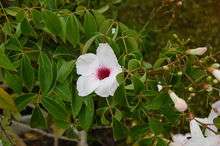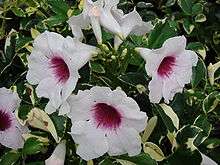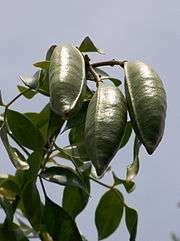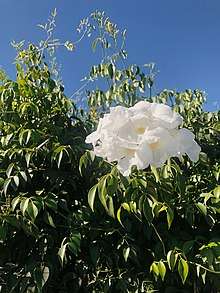Pandorea jasminoides
Pandorea jasminoides, the bower of beauty,[2] bower vine or bower plant, is a species of woody climbing vine in the family Bignoniaceae native to the forests of eastern Australia that is grown as an ornamental plant.
| Pandorea jasminoides | |
|---|---|
 | |
| Scientific classification | |
| Kingdom: | Plantae |
| Clade: | Tracheophytes |
| Clade: | Angiosperms |
| Clade: | Eudicots |
| Clade: | Asterids |
| Order: | Lamiales |
| Family: | Bignoniaceae |
| Genus: | Pandorea |
| Species: | P. jasminoides |
| Binomial name | |
| Pandorea jasminoides | |
| Synonyms[1] | |
| |
Description


Growing to 8 m (26 ft), it is a climbing plant that has compound, evergreen leaves. The mainly opposite, sometimes three-part whorled leaves are unpaired pinnate and about 12 to 17 cm long with a 2 to 4 cm long petiole. They consist of four to seven leaflets that are 4.5 to 6 inches long and 1.5 to 3 inches wide. The leaflets have a smooth edge and sit on a 2 to 4 millimeter long stem; the base of the leaflets is asymmetrical. Stipules are missing.
Inflorescence
In spring and summer, it produces 4 to 6 centimeters long trumpet-shaped flowers, which are white or pale pink[2] with a hairy, deep maroon throat, and fragrant. The petals are around 55mm long. The inflorescences sometimes appear to be racemose; they are 6 to 12 inches long. The hermaphrodite, five-fold flowers are more or less zygomorphic.
The crown is coarsely hairy on the inside and short-haired on the outside. The trumpet-shaped crown is more or less upright and has a diameter of 10 to 20 millimeters.[3]
Fruit
It forms large pointed pods filled with papery seeds, and is easy to germinate, having two-lobed dicotyledons. A capsule fruit is formed that is 4 to 6 centimeters long and has a diameter of about 1 to 2 centimeters. The flat seeds are almost completely surrounded by a membranous wing and have a diameter of 10 to 15 millimeters.
Distribution

It naturally occurs in the sclerophyllous forests in the humid tropics New South Wales and Queensland, Australia, where it grows in the subtropical coastal forests or dry forests therein.
Cultivation
It grows in USDA zones 9 and 10. It usually does not tolerate temperatures below 5 °C (41 °F), especially when young, and must be grown in a cool greenhouse or conservatory. Plants may be placed outside during summer months. Because of their many, striking, trumpet-shaped flowers and their long flowering period, varieties of this type are used as ornamental plants.
It has gained the Royal Horticultural Society’s Award of Garden Merit.[4][5]
References
- The Plant List: A Working List of All Plant Species, retrieved 11 September 2016
- "Growing native plants: Pandorea jasminoides". Australian National Botanic Gardens. Retrieved 17 April 2018.
- Gordon Cheers (ed.): Botanica. The ABC of plants. 10,000 species in text and images. Koenemann Publishing Company, 2003, ISBN 3-8331-1600-5 (page 634).
- "RHS Plantfinder - Pandorea jasminoides". Retrieved 18 April 2018.
- "AGM Plants - Ornamental" (PDF). Royal Horticultural Society. July 2017. p. 71. Retrieved 17 April 2018.
External links
![]()
![]()
- "Pandorea jasminoides". Australian Plant Name Index (APNI), IBIS database. Centre for Plant Biodiversity Research, Australian Government.
- Nickel, E. Pandorea jasminoides a good coverage vine San Francisco Chronicle 8 November 2009.